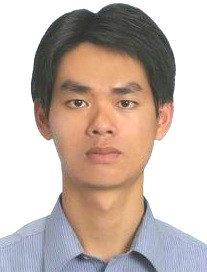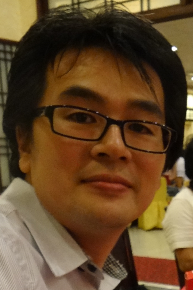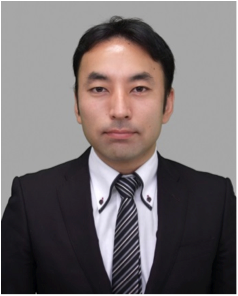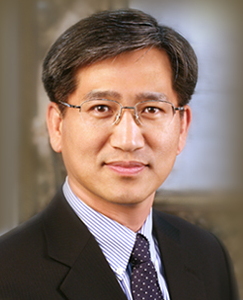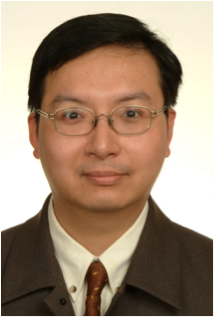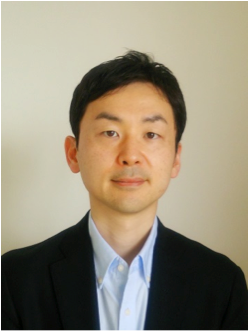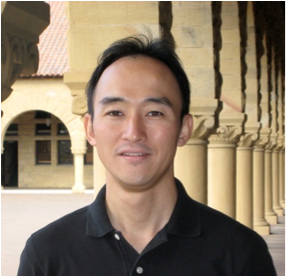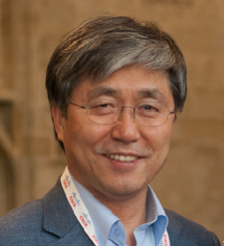Special Sessions
Session 1: Thurs., Sept. 18, 2014, 13:10-14:50, Conference Room 4
Topic: Management of Disaster Response Networks
Chair: Dr. Ling-Jyh Chen (Academia Sinica, Taiwan)
Communications Infrastructure Recovery for Disaster Responses (slides) Dr. Wei-Ho Chung (Academia Sinica, Taiwan) |
|
|
Abstract: Unpredictable natural or manmade disasters often cause the outages of communications. The fast recovery of communications infrastructure is crucial in providing decision makers, responders, victims and general public the vital data and information for the timely responses. In traditional systems, a communication component failure may take up to hours or even days for recovery, which severely jeopardizes the requirement of timely command and control operations. In this session, we will give an overview of the modern communications recovery mechanisms, including network layer and physical layer techniques. The design considerations for the infrastructure recovery will be briefly introduced and the relevancy to the disaster management will be discussed. Bio: Wei-Ho Chung received the B.Sc. and M.Sc. degrees in Electrical Engineering from the National Taiwan University, Taipei, Taiwan, in 2000 and 2002, respectively, and the Ph.D. degree in Electrical Engineering from the University of California, Los Angeles, in 2009. From 2002 to 2005, he was a system engineer at ChungHwa Telecommunications Company, where he worked on data networks. In 2008, he worked on CDMA systems at Qualcomm, Inc., San Diego, CA. His research interests include communications, signal processing, and networks. Dr. Chung received the Taiwan Merit Scholarship from 2005 to 2009 and the Best Paper Award in IEEE WCNC 2012, and has published over 30 refereed journal articles and over 40 refereed conference papers. Since January 2010, Dr. Chung has been a tenure-track assistant research fellow, and promoted to the rank of associate research fellow in January 2014. He leads the Wireless Communications Lab in the Research Center for Information Technology Innovation, Academia Sinica, Taiwan. |
Disaster Resilient Communication and Applications (slides) Prof. Yao-Hua Ho (National Taiwan Normal University, Taiwan) |
|
|
Abstract: In the last few years, we have witness many disasters which destroyed communication networks to the outside world. Wireless mesh network (WMN) is one of the best choices for establishing a network during disaster recovery. In most disaster area, the reliability of WMNs decreased rapidly due any unpredictable environment changes. The disruption of services are often introducing delay and dropping of important and live saving messages. Thus, it is desirable to have a disaster resilient network that can temporarily withstand one or multiple of failed mesh nodes. In this talk, we discuss Disaster Resilient Network (DRN) for tunnels and bridges that allows mesh clients to contribute and retain the connectivity of the network. Bio: YAO HUA HO (yho@csie.ntnu.edu.tw) received his B.S., M.S., and Ph.D. degrees in computer science from the University of Central Florida in 2001, 2002, and 2009, respectively. He joined the in the Department of Computer Science and Information Engineering at National Taiwan Normal University as an Assistant Professor in 2012. He has published widely, including several papers recognized as best/top papers at various international conferences. His research interests include social networks and computing, mobile, and wireless networks (WLAN/WSN/MANET/VNET), network protocols, mobile applications (iPhone/Android/platform), location-aware service, and network measurements. |
NerveNet: Resilient Network and Application Service Platform for Safe and Secure Regional Society (slides) Dr. Yasunori Owada (NICT, Japan) |
|
|
Abstract: In the Great East Japan Earthquake, weakness in the existing network have been revealed. In such emergency situation as disconnection from the core network, the local communication services should be continue among the available network infrastructures and terminals. In addition, it is required to deploy temporary network and application service as soon as possible until the recovery of damaged network system. We have been developing NerveNet as a platform that contains such features. In this presentation, the NerveNet architecture, platform and applications are introduced. Bio: Yasunori Owada received the B.E., M.E. and Ph.D. of engineering from Niigata University in 2002, 2004 and 2007, respectively. He is currently a Senior Researcher at NICT. He is involved in designing distributed wireless access network architecture, information/contents centric network, in-network processing architecture at Resilient ICT Research Center. Dr. Owada was involved in a research and development on practical application of mobile ad hoc networks for disaster communication at Research Institute for Natural Hazard and Disaster Recovery, Niigata University, Japan as Assistant Professor from 2007 to 2008. He was then involved in development of a wireless network simulator at Space-Time Engineering Japan, Inc., serving as President from 2008 to 2010. He is a member of IPSJ, IEICE and IEEE. |
Integrated Control and Management of Disaster Emergency Response Networks (slides) Prof. Young-Tak Kim (Youngnam University, Korea) |
|
|
Abstract: The most important role of public safety communication network in disaster emergency response activity is providing the well-organized audio visual information of the disaster site for fast and efficient rescue activities. Especially when the public safety communication infra cannot provide proper broadband communications in the building basements, mountain valley area and offshore sea, ad hoc networking should be connected to the backhaul public safety communication network. In this presentation, we review the overall public safety communication network and ad hoc networking at disaster emergency rescue operations, and the integrated control and managements for realtime multimedia communications for fast and efficient rescue activities. Bio: Prof. Young-Tak Kim received Ph.D. degree from KAIST in February 1990. He joined Korea Telecom (KT) in 1990, where he had researched and developed the ATM MAN Switching System (ATM-MSS) and related network operations and management technologies for broadband networking. Currently he is a professor of the Department of Information and Communication Engineering, College of Engineering in Yeungnam Univ., Korea. In 2001 and 2008, he had been working as a visiting scholar at NIST (National Institute of Standards and Technology), USA, where he joined in the design and implementation of NIST GMPLS simulator (GLASS) and Next Generation Routing Architecture (NGRA) project. His research interests include QoS-guaranteed traffic engineering in future Internet, Cloud Computing, QoS-aware Network Operating System, OpenFlow, QoS-aware seamless secure mobility, and related network operations and managements. He is a member of IEEE Communication Society, KICS, KISS, KIPS, and Korea Multimedia Society. He had been the Technical Program Chair of IEEE ComSoc CNOM in the period of 2007-2008, TPC Co-chair of IM2009 and the general chair of APNOMS2009. |
Session 2: Fri., Sept. 19, 2014, 10:30-12:10, Conference Room 4
Topic: Practical Approach for Virtualized/Software-Defined Networks Management
Chair: Dr. Kazuhiko Kinoshita (Osaka University, Japan)
Large-Scale SDN Testbed over TWAREN and SDN-Based Resource Management Prof. Li-Der Chou (National Central University, Taiwan) |
|
|
Abstract: Software Defined Network (SDN) enables researchers to design novel network protocols by separating control plane and data plane and hence brings revolutionary impact to current network industry. In 2009, National Center for High-performance Computing (NCHC) started to construct a large-scale SDN Testbed over TWAREN (TaiWan Advanced Research and Education Network) backbone involving domestic and international research organizations. In order to monitor flows across different administrative domains, NCHC implemented a multi-domain automatic network topology discovery mechanism to observe network status and troubleshoot flow status. The large-scale SDN Testbed composes of seven universities and companies in Taiwan, and connects to iCAIR in US, SURFnet in the Netherlands, and JGN-X in Japan. In addition, the speaker will present his research on SDN-based cloud resource management, including load balancing, virtual network management, cloud resource control, and DoS attack mitigation. Bio: Li-Der Chou received the M.S. degree and Ph.D. degree in electronic engineering from National Taiwan University of Science and Technology, Taipei, Taiwan, in 1991 and 1995, respectively. He is currently the Deputy Director General with the National Center for High-Performance Computing, Taiwan, and a Distinguished Professor with the Department of Computer Science and Information Engineering, National Central University, Taoyuan, Taiwan. Dr. Chou is also the Secretary-General of the Computer Society of the Republic of China. He is the author or co-author of more than 200 journal and conference papers in the area of computer networks. He is the holder of 5 U.S. and 15 Taiwan invention patents. Dr. Chou served as the Principal Investigator of an interdisciplinary project in the application of information and communication technologies to families with children with developmental disabilities and individuals with cognitive impairments. His research interests include vehicular networks, network management, broadband wireless networks, and Internet services. Dr. Chou has been invited to join many technical program committees of international conferences. He has received two Best Paper Awards and three Excellent Paper Awards from international conferences. He has won two Gold Medal Awards and four Silver Medal Awards in many international invention shows held in Geneva, Moscow, London, and Taipei. |
Evolution of SDN services in NTT Communications and management issues to be resolved for future services (slides) Dr. Dai Kashiwa (NTT Communications, Japan) |
|
|
Abstract: Telecom operators put their hopes on virtualized / Software-Defined networks (SDN) technologies from the point of view of reducing CAPEX (CAPital EXpeses) and OPEX (OPerating EXpenses) and shortening period of services evelopment. First, I explain about the evolution of SDN services in NTT Communications. We have expanded SDN technologies into DC(Data Center)s and VPNs, and will expand into WANs. Second, I mention some management issues to be resolved for future virtualized/ SDN services and our activities on them, which include management framework and DevOps tools for virtualized / SDN services. Bio: Dai Kashiwa received his Bachelor's and Master's degrees from Keio University, Japan in 1995 and 1997, respectively. In 1997, he joined NTT and had been involved in research including network management system, network security and Active Networks. Since 2004, he had worked for NTT Communications, where he developed network services including video broadcasting and dynamic VPN. From 2002 he joined Keio University again and received the Ph.D. degree in 2004. In 2013, he had started developing SDN services. |
ODENOS: A modularized SDN controller platform for multi-layer/heterogeneous networks (slides) Dr. Masayoshi Kobayashi (NEC, Japan) |
|
|
Abstract: The advent of SDN has removed the constraints brought about by rigid control protocols, thereby enabling a flexible description of control software as an SDN controller, which meets the needs of network operators. Further simplification in creating SDN controllers will become an issue in the need to create more SDN controllers quickly. This paper proposes a network abstraction model that makes it possible to simplify the description for the virtualization of network resources and the implementation of complex path control algorithms while absorbing differences in control protocols between network devices. It is also shown that an SDN controller can be created quickly and simply using the SDN controller platform prototype that was designed based on the proposed model. Bio: Masayoshi Kobayashi received his Bachelor's and Master's engineering degrees from Kyoto University, Japan in 1995 and 1997, respectively. In 1997, he joined NEC and had been involved in research including high-speed routers, contents-delivery network, congestion control, network measurements and OpenFlow/SDN. From 2007 to 2012, he was with Prof. Nick McKeown’s group at Stanford as a visiting researcher from NEC, where he was one of the first to be involved in the OpenFlow project. He led OpenFlow network deployments in Stanford and eight universities attending GENI project and contributed to define OpenFlow specification and to mature early-stage OpenFlow switches and open-source controllers. From 2012 to 2014, he was with Open Networking Laboratory, where he was developing a distributed SDN controller, called ONOS (Open Network Operating System). He moved back to NEC Japan in May 2014 and since then he has been leading OpenFlow/SDN research team. |
Management Framework Using SDN for Open Source Based Mobile R&D Networks and Considerations for NFV of Cellular Networks (slides) Prof. Choong Seon Hong (kyung Hee University, Korea) |
|
|
Abstract: In this presentation, we introduce the open source based mobile networks and its management framework in Korea Research Networks. The mobile networks include WiFi, Cellular and Femto networks. The all service functions for mobile networks are deployed on the cloud service platform. As practical services, we implemented VoIP and MVNO services. Also we share you our experiences in the process for the construction of experimental networks. In addition, we introduce the considerations and orchestration architecture for NFV in order to manage LTE network resources. Bio: Choong Seon Hong received his B.S. and M.S. degrees in electronic engineering from Kyung Hee University, Seoul, Korea, in 1983, 1985, respectively. In 1988 he joined KT, where he worked on Broadband Networks as a member of the technical staff. From September 1993, he joined Keio University, Japan. He received the Ph.D. degree at Keio University in March 1997. He had worked for the Telecommunications Network Lab., KT as a senior member of technical staff and as a director of the networking research team until August 1999. Since September 1999, he has worked as a professor of the department of computer engineering, Kyung Hee University. He has served as a General Chair, TPC Chair/Member, or an Organizing Committee Member for International conferences such as NOMS, IM, APNOMS, E2EMON, CCNC, ADSN, ICPP, DIM, WISA, BcN, TINA, SAINT, ICOIN, ICC and so on. Also, he is now an associate editor of IEEE Transactions on Network and Service Management, International Journal of Network Management, Journal of Communications and Networks, and an Associate Technical Editor of IEEE Communications Magazine. And he is a Senior Member of IEEE, and a Member of ACM, IEICE, IPSJ, KIISE, KICS, KIPS and OSIA. His research interests include Future Internet, Ad hoc Networks, Network Management, and Network Security. |
